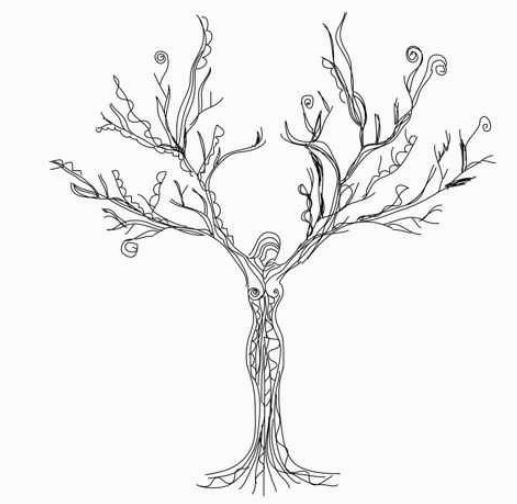
The image I chose is a line drawing of a tree, but the trunk/body of the tree is a woman’s form. This supports the idea that nature is very much rooted with female and sexual terms.
Hobgood-Oster defines ecofeminism as a “multi-faceted and multi-located, challenging structures rather than individuals”. The term first came into fruition when ecofeminism emerged in the 1970s and 1980s and Francoise d’Eaubonne coined the term in her book, Le Feminisme ou la Mort (Feminism or Death). Theorists disagree on how to classify this. Some would say it should be name third wave feminism and others would say it is in the category of deep ecology. Ecofeminism essentially combines “feminist and deep ecological perspectives”. Eco-feminists believe that all forms of dualism and binaries should be dismantled “otherwise humanity remains divided against itself”. These binaries and dualities include, but not limited to heaven/earth, mind/body, male/female, human/animal, spirit/matter, culture/nature, and white/non-white.
I found Warren’s fourth connection between nature and women to be the most interesting mainly because I have thought this before, back before I knew anything about ecofeminism. I don’t remember exactly where or why I was reading about nature, but the way women were described, I found them to be sexist. Like Warren said, “women are often described in animal terms … nature is often described in female and sexual terms”. In greek mythology, there was Dionysus and Demeter. Both had control of nature in some form, Dionysus of grape harvest and Demeter of agriculture. Demeter’s symbols include the cornucopia, wheat, bread, and the torch. Dionysus’ symbols include a bull, panther, ivy, goat, masks, chalice, grapevine, and thyrsus. Although, they are very different gods and goddesses, they are also quite similar. Demeter’s symbols only represent one part of her, not a lot of people knew she was also the goddess of fertility, sacred law, and the cycle of life and death.

Hi Winnie! I think the image that you chose is perfectly suited for ecofeminism. It does not just represent women as being alongside nature, but rather one with nature, and I feel that this better suits what most feminists describe as ecofeminism. As for Warren’s 8 connections between women and nature, I also feel that number 4 had caught my attention. I feel that there have been a lot of symbols such as these that have been used to put women down. A lot of these include derogatory names for women such as bitches or whales. I’ve seen these phrases gotten tossed around plenty of times online and several times in real life. And when nature is feminized I tend to find it even more uncomfortable. Maybe this is due to how fragile and volatile nature can be, but whenever mother nature is described as being dominated or overpowered, I can’t help but feel uneasy. The entire idea of gendering nature and using dehumanizing and animalistic terms towards women is definitely an interesting subject to look into, and I’m wondering if were going to take another look in one of our next classes.
Great work! I enjoyed reading your blog and I’m looking forward to reading more!